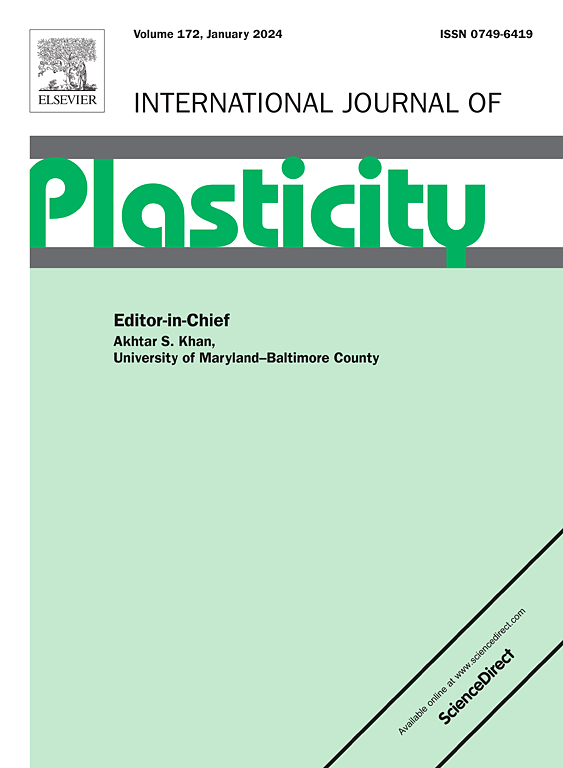CoCrNi复合介质熵合金中多剪切带的自组织
IF 9.4
1区 材料科学
Q1 ENGINEERING, MECHANICAL
引用次数: 0
摘要
复杂浓缩合金(CCAs)又称中/高熵合金(M/HEAs),由于其独特的无序化学结构而具有许多优异的性能,在许多工程领域具有广阔的应用前景。剪切局部化作为一种基本的、普遍存在的非平衡现象,在过去的几十年里受到了广泛的关注。然而,CCAs或M/HEAs中多个剪切带的集体行为尚未得到全面阐明。本文采用厚壁圆筒技术解决了CoCrNi中熵合金的这一问题。通过实验设计,将不同变形的试件有效地“冻结”,从而有利于获取不同演化阶段的多个剪切带的自组织特征。发现了多个剪切带间距的显著标度规律。为了揭示标度规律的物理机制,建立了多剪切带能量耗散演化动力学模型。随后,建立了剪切带成核和生长的竞争图。发现层错和孪晶的协同扩展可能引发剪切带生长后期由面心立方结构向六方密排结构转变甚至非晶化。非晶化区有很高的可能性作为成核点,有形成空洞的倾向。最终,随着孔隙演化的进行,发生断裂。本文章由计算机程序翻译,如有差异,请以英文原文为准。
Self-organization of multiple shear bands in CoCrNi chemically complex medium entropy alloys
Complex concentrated alloys (CCAs), also known as medium/high entropy alloys (M/HEAs), possess a multitude of outstanding properties attributing to their distinctive chemically disordered structure, which endows them with broad application prospects in many engineering fields. As a fundamental and ubiquitous non-equilibrium phenomenon, shear localization has received significant attention during past several decades. However, the collective behavior of multiple shear bands in CCAs or M/HEAs has not been comprehensively elucidated. Here, we tackle this problem in CoCrNi medium entropy alloy by thick-walled cylinders technology. Via the experimental design, the specimens subjected to diverse deformations were effectively "frozen", thereby facilitating the acquisition of the self-organization characteristics of multiple shear bands in distinct evolution stages. A notable scaling law of multiple shear band spacing was identified. To uncover the underlying physical mechanism of the scaling law, a multiple shear band energy dissipation evolution dynamics model was formulated. Subsequently, a competing map of shear band nucleation and growth was established. It is found that the coordinated propagation of stacking faults and twins may trigger the transformation from the face-centered cubic structure to the hexagonal close-packed structure and even amorphization in late stage of shear band growth. The amorphization regions possess a high probability of serving as nucleation sites with a propensity for void formation. Eventually, with the progression of void evolution, fracture occurs.
求助全文
通过发布文献求助,成功后即可免费获取论文全文。
去求助
来源期刊

International Journal of Plasticity
工程技术-材料科学:综合
CiteScore
15.30
自引率
26.50%
发文量
256
审稿时长
46 days
期刊介绍:
International Journal of Plasticity aims to present original research encompassing all facets of plastic deformation, damage, and fracture behavior in both isotropic and anisotropic solids. This includes exploring the thermodynamics of plasticity and fracture, continuum theory, and macroscopic as well as microscopic phenomena.
Topics of interest span the plastic behavior of single crystals and polycrystalline metals, ceramics, rocks, soils, composites, nanocrystalline and microelectronics materials, shape memory alloys, ferroelectric ceramics, thin films, and polymers. Additionally, the journal covers plasticity aspects of failure and fracture mechanics. Contributions involving significant experimental, numerical, or theoretical advancements that enhance the understanding of the plastic behavior of solids are particularly valued. Papers addressing the modeling of finite nonlinear elastic deformation, bearing similarities to the modeling of plastic deformation, are also welcomed.
 求助内容:
求助内容: 应助结果提醒方式:
应助结果提醒方式:


